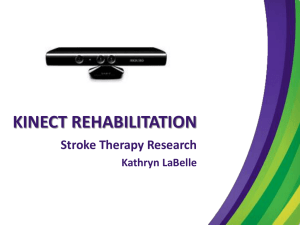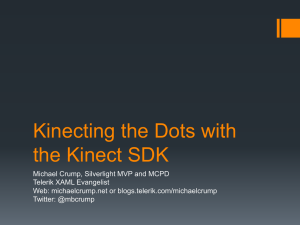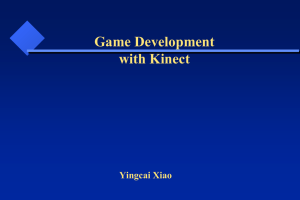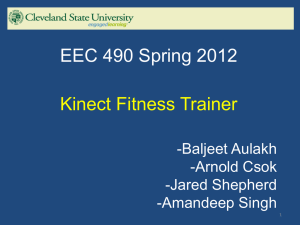slides
advertisement
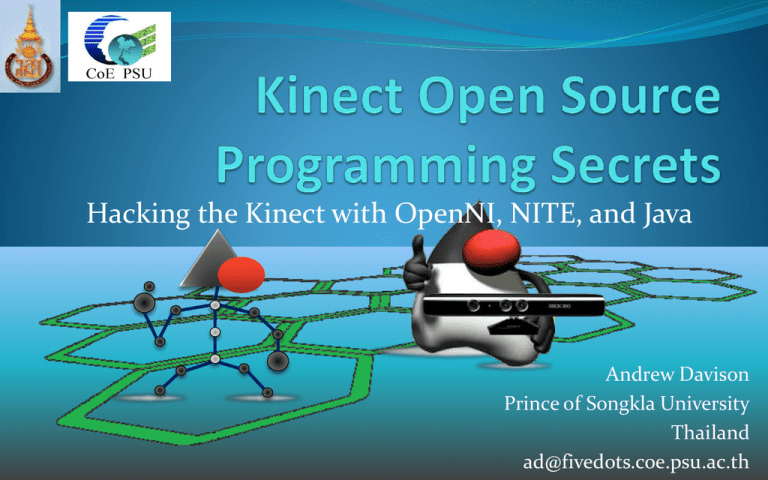
Hacking the Kinect with OpenNI, NITE, and Java
Andrew Davison
Prince of Songkla University
Thailand
ad@fivedots.coe.psu.ac.th
http://fivedots.coe.psu.ac.th/~ad/kinect
Overview
1. The Kinect Sensor
2. Maps
3. Skeletons
4. Hand Points
and Gestures
5. Computer Vision
6. Augmented Reality
7. Summary
KOPS Talk (JavaOne 2012)
using OpenNI
using NITE
as an input source
to other libraries
Eight examples
(if I have time)
2
1. The Kinect Sensor
one microphone
(downward facing)
status LED
CMOS color sensor
(for RGB imaging)
three-axis
accelerometer
three microphones
(downward facing)
IR light
source
CMOS IR
sensor
used for 3D
depth sensing
KOPS Talk (JavaOne 2012)
motorized
tilting base
(up/down ~30)
3
2. Depth, Image, IR Maps
The IR light emits a
fixed pattern of spots
(randomly distributed)
KOPS Talk (JavaOne 2012)
4
Map Generation
initialize context
and generator(s)
Depth
Generator
Image
Generator
OR
wait on context update
read map
repaint
KOPS Talk (JavaOne 2012)
Depth
Map
IR
Generator
OR
Image
Map
IR
Map
camera
image
5
Initialization
Context context = new Context();
License license = new License("PrimeSense",
"0KOIk2JeIBYClPWVnMoRKn5cdY4=");
context.addLicense(license);
DepthGenerator depthGen = DepthGenerator.create(context);
MapOutputMode mapMode = new MapOutputMode(640, 480, 30);
// xRes, yRes, FPS
depthGen.setMapOutputMode(mapMode);
context.setGlobalMirror(true);
context.startGeneratingAll();
KOPS Talk (JavaOne 2012)
6
Wait, Read, Repaint Loop
while (isRunning) {
try {
context.waitAnyUpdateAll();
}
catch(StatusException e)
{ System.out.println(e);
System.exit(1);
}
updateDepthImage(); // my code
repaint();
}
try {
// close down
context.stopGeneratingAll();
}
catch (StatusException e) {}
context.release();
KOPS Talk (JavaOne 2012)
7
OpenNI Generators
primarily used
by middleware
(e.g. NITE)
KOPS Talk (JavaOne 2012)
8
2.1. Transforming the User
later
The transformation is applied to all of the camera image,
but transparent parts of the changed image aren't visible.
KOPS Talk (JavaOne 2012)
9
Time-based changes
cycle through blurring
Center-of-mass (CoM) based changes
change stays
centered on
user
KOPS Talk (JavaOne 2012)
10
Building the Scene
set alternative
viewpoint
Depth
Image
Generator
Generator
for real world
coordinates to 2D
(projective)
mapping
camera
image
User
Generator
Scene
MetaData
remove
background
scene map
(user ID map)
Java 2D filterOp
http://www.jhlabs.com/ip/filters/
KOPS Talk (JavaOne 2012)
CoMs of
user IDs
(optional)
11
Panel Execution
initialize context
and generator(s)
wait on context update
update
repaint
KOPS Talk (JavaOne 2012)
• remove background
of camera image;
• apply filterOp
(optionally based on
time and CoM of user)
• draw background image
• draw camera image;
12
3. OpenNI Skeleton
There are 15 joints
(and 9 more that are
not currently
initialized by the
skeleton capability).
On-screen view,
with mirroring
enabled
KOPS Talk (JavaOne 2012)
13
3.1. Heads and Backgrounds
switch heads and backgrounds
(via keyboard or dialog selection)
KOPS Talk (JavaOne 2012)
14
Generators (and Capabilities)
set alternative
viewpoint
Depth
Image
Generator
Generator
for real world
coordinates to 2D
(projective)
mapping
User
Generator
Scene
MetaData
:
Skeleton
Capability
Pose
Capability
:
listeners
for various
user events
camera image
KOPS Talk (JavaOne 2012)
scene map
(user ID map)
15
Rotating the Head Image
Calculated using
the head and neck
coordinates.
KOPS Talk (JavaOne 2012)
16
3.2. Viewing Users in 3D
rendered using Java 3D
for each
user
joints and limbs
KOPS Talk (JavaOne 2012)
17
Creating a Skeleton
user has
exited
new user
Depth
Generator
for real world
coord to 2D
(projective)
mapping
KOPS Talk (JavaOne 2012)
User
Generator
user has
reentered
calibration
completed
lost user
Skeleton
Capability
add a
Skeleton
object to
the 3D scene
calibration
starting
Pose
Capability
psi pose
detected
18
Overview
1. The Kinect Sensor
2. Maps
3. Skeletons
4. Hand Points
and Gestures
5. Computer Vision
6. Augmented Reality
7. Summary
KOPS Talk (JavaOne 2012)
using OpenNI
using NITE
as an input source
to other libraries
19
4. NITE Hand Points and Gestures
NITE gestures are derived from a stream of hand
points which record how a hand moves through
space over time.
Gesture detectors are sometimes called point
listeners (or point controls) since they analyze the
hand points stream looking for gestures.
KOPS Talk (JavaOne 2012)
20
NITE Gesture Classes
KOPS Talk (JavaOne 2012)
21
4.1. Gesture GUIs (GGUIs)
KOPS Talk (JavaOne 2012)
22
Controlling the GGUIs
Depth
Generator
Hands
Generator
Gesture
Generator
for coords mapping
Image
Generator
for camera image
Session
Manager
session ended (S)
Point
Control
new hand point (P1)
no active hand points (P3)
KOPS Talk (JavaOne 2012)
hand point moved (P2)
update GGUI
deactivate GGUI
23
Overview
1. The Kinect Sensor
2. Maps
3. Skeletons
4. Hand Points
and Gestures
5. Computer Vision
6. Augmented Reality
7. Summary
KOPS Talk (JavaOne 2012)
using OpenNI
using NITE
as an input source
to other libraries
24
http://opencv.willowgarage.com
5. Computer Vision and the Kinect
Use the Kinect sensor as input to JavaCV
(a Java binding for OpenCV)
input can be RGB and/or depth reading
Current and past (student) projects:
motion detection
face detection & recognition
eye tracking
KOPS Talk (JavaOne 2012)
25
5.1. Hand Recognition
KOPS Talk (JavaOne 2012)
26
From OpenNI to OpenCV
Depth
Generator
Depth
Map
threshold
smooth
largest
contour
KOPS Talk (JavaOne 2012)
27
largest contour
convex hull
convexity defects
start pt
end pt depth
depth pt
each defect is a tuple:
(start pt, end pt, depth pt, depth)
KOPS Talk (JavaOne 2012)
28
simplified
convexity defects
start pt
end pt depth
depth pt
KOPS Talk (JavaOne 2012)
remove defects with:
• shallow depths
• small angles between
the start and end pts
29
Finger Labeling
index middle
angle to
the horizontal
thumb
center of
gravity (cog)
ring
little
• rotate hand image to match
predefined hand 'parameters'
fragile, hacky
KOPS Talk (JavaOne 2012)
30
Uses?
move
wave
finger rotate
hold
hold & tap rotate two
KOPS Talk (JavaOne 2012)
zoom/pinch
pick & drop
cover
double tap
cluster & move
multi slide
zoom spot
hide
31
6. Augmented Reality (AR)
A combination of a
real scene and
virtual elements
generated by the
computer.
Uses the Kinect
camera as input to
NyARToolkit
http://nyatla.jp/nyartoolkit/wp/?page_id=198
KOPS Talk (JavaOne 2012)
32
Using NyARToolkit and Java 3D
Image
Generator
search for
Hiro marker
using NyARToolkit
calculate
its position
and orientation
video stream
from the
Kinect
KOPS Talk (JavaOne 2012)
render model
in front of the
video frame
using Java 3D
apply position
and orientation
to marker
model
33
The User's Viewpoint
+Y
+X
model
+Z
background
KOPS Talk (JavaOne 2012)
34
7. Summary
OpenNI
RGB, depth, IR maps
skeletal tracking,
scene/user IDs
NITE
hand points, hand
gestures
KOPS Talk (JavaOne 2012)
7 Examples
aligned maps
user transformation
heads & backgrounds
3D users
gesture GUIs
hand recognition
augmented reality (AR)
35
Topics not Discussed
Tilt motor, LED, accelerometer
easy to add using LibusbJava
left
right
θ
positive negative
Audio source input, speech recognition, beamforming
using MS Kinect audio driver, JSAPI, TalkingJava,
Motion detection, face recognition, eye tracking
Multiple-marker AR
Games – Kinect breakout
KOPS Talk (JavaOne 2012)
36
More Information
All the code, draft chapters,
and extra examples,
are available at my website:
http://fivedots.coe.psu.ac.th/
~ad/kinect/
KOPS Talk (JavaOne 2012)
37
One last example...
KOPS Talk (JavaOne 2012)
38
8. Where I work...
I'm an Ajarn (lecturer) in the
Department of Computer
Engineering (CoE),
Faculty of Engineering,
Prince of Songkla University (PSU)
I'm based at the Hat Yai campus,
Songkhla province, in the south of
Thailand.
KOPS Talk (JavaOne 2012)
39
PSU at a Glance...
Surat Thani
• 1st university in Southern
Thailand, est. 1967
• 5 campuses
• 39,000 students (2012)
Hat Yai
Phuket
Trang
Pattani
Prince of Songkla University
(PSU), Hat Yai campus
Department of
Computer Engineering (CoE)
Faculty of Engineering
KOPS Talk (JavaOne 2012)
41
KOPS Talk (JavaOne 2012)
42
Department of Computer Engineering (CoE)
KOPS Talk (JavaOne 2012)
43
PSU Academically...
A National Research University (NRU)
Ranked 4th in the Nation in terms of publications
Research strong points include:
Natural rubber
Biodiesel and energy
Sea food and Halal food
Marine sciences
Nanotechnology
Peace studies
KOPS Talk (JavaOne 2012)
44
CoE Research Groups and Interests
Center for Network Research (CNR)
Wireless Sensor Network (WSN)
ANW Informatics Laboratory
Intelligent System (iSys) Research Team
Computer Control and Robotics
Computer System Design and VLSI Design
KOPS Talk (JavaOne 2012)
45


